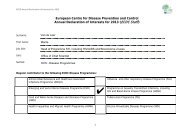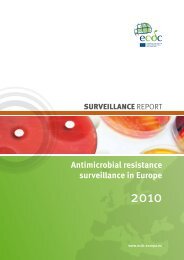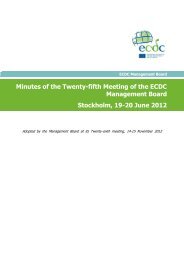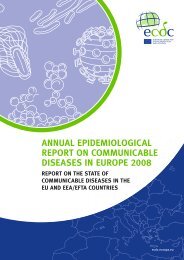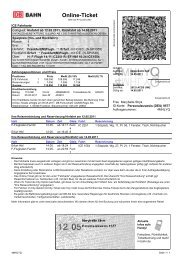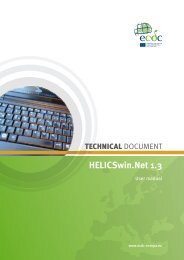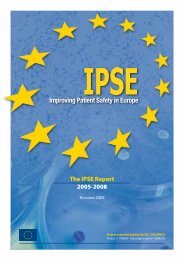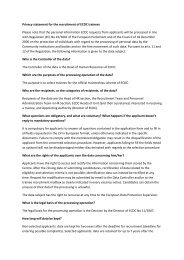External quality assurance scheme for Haemophilus influenzae 2011
External quality assurance scheme for Haemophilus influenzae 2011
External quality assurance scheme for Haemophilus influenzae 2011
Create successful ePaper yourself
Turn your PDF publications into a flip-book with our unique Google optimized e-Paper software.
<strong>External</strong> <strong>quality</strong> <strong>assurance</strong> <strong>scheme</strong> <strong>for</strong> <strong>Haemophilus</strong> <strong>influenzae</strong><br />
TECHNICAL REPORT<br />
The evaluation of biotyping was good in <strong>2011</strong> and improved in the biotyping of biotype 1 when compared with<br />
2009.<br />
In <strong>2011</strong>, genotypic capsular typing was very good, with only two laboratories attempting to genotype<br />
H. para<strong>influenzae</strong>, which was not appropriate.<br />
In <strong>2011</strong>, the antimicrobial susceptibility testing proved rather problematic, as it was in 2009. Laboratories used<br />
different guidelines (CLSI or EUCAST); some reported zone sizes while others reported MIC values, making<br />
comparison of results difficult, as observed in 2009. Again in <strong>2011</strong>, identification of BLNAR (β-lactamase-negative<br />
ampicillin-resistant) strains proved challenging.<br />
Overall comments<br />
The laboratory EQA has shown that European <strong>Haemophilus</strong> reference laboratories vary in the level to which they<br />
characterise strains referred to them, ranging from simple speciation to full identification. Similarly, some<br />
laboratories per<strong>for</strong>m PCR-based capsular based genotyping and antimicrobial susceptibility testing.<br />
This EQA distribution identified some problems with the use of conventional serotyping by slide agglutination. The<br />
results can be misinterpreted when there are problems such as non-specific agglutination, cross-reactions and<br />
auto-agglutination. Satola et al. (2007) found that H. <strong>influenzae</strong> isolates were misidentified by conventional<br />
H. <strong>influenzae</strong> serotyping in 17.5% of cases.<br />
Discrepancies varied by serotype and usually resulted in overreporting of genotypically non-capsulated strains of H.<br />
<strong>influenzae</strong> as encapsulated strains. The results of this EQA exercise clearly indicate that PCR-based speciation and<br />
capsular genotyping gives more reliable results <strong>for</strong> the identification and capsular typing of strains of H. <strong>influenzae</strong><br />
than the results obtained by conventional phenotypic methods.<br />
The antimicrobial susceptibility testing results proved difficult to assess as some laboratories gave MIC values,<br />
while others gave zone sizes, with or without interpretation of the results. Some laboratories are using EUCAST<br />
guidelines while others are still using CLSI guidelines. There are major differences between the EUCAST and CLSI<br />
both in terms of media and defined breakpoints <strong>for</strong> a number of antimicrobials. All EU reference laboratories should<br />
be moving towards using EUCAST guidelines. There were no problems with the detection of β-lactamase<br />
production. However the evaluation of β-lactamase-negative ampicillin resistance (BLNAR) proved more difficult.<br />
There is some evidence that the prevalence of ampicillin resistance of H. <strong>influenzae</strong> in Europe may be decreasing<br />
due to a reduction in the number of β-lactamase-positive ampicillin-resistant strains, whereas the prevalence of<br />
BLNAR strains is relatively stable (Jansen et al., 2006). The level of ampicillin resistance exhibited by BLNAR strains<br />
may be low (MIC 0.5–2 μg/ml) and this may make their detection difficult, particularly if a breakpoint of 1μg/ml is<br />
used to define ampicillin susceptibility.<br />
Using PCR and sequencing to detect specific mutations in the ftsI gene and associated PBP 3 substitutions, strains<br />
can be categorised as BLNAR. Low BLNAR usually have ampicillin MICs in the range 0.5 to 2.0 μg/ml, and high<br />
BLNAR have ampicillin MICs in the range 1.0 to 16.0 μg/ml. García-Cobos et al. (2008) suggest that low BLNAR<br />
strains are best detected by broth dilution methods rather than disc susceptibility testing.<br />
BLNAR strains show reduced susceptibility not only to ampicillin but also to other β-lactam antibiotics, particularly<br />
some of the cephalosporins. Livermore et al. (2001) suggested that cefaclor resistance is a better indicator of a<br />
BLNAR strain than ampicillin resistance and James et al. (1996) used cefuroxime resistance (MIC >4.0 μg/ml) to<br />
screen <strong>for</strong> BLNAR strains. CLSI recommends that BLNAR strains are considered resistant to co-amoxyclav, cefaclor<br />
and cefuroxime, despite apparent susceptibility of some strains to these antimicrobials.<br />
Nørskov-Lauritsen et al. (<strong>2011</strong>) evaluated the efficacy of disk diffusion methods <strong>for</strong> the detection of low-BLNAR.<br />
Forty-seven low-BLNAR strains of H. <strong>influenzae</strong>, identified by partial sequencing of the ftsI gene had low-level<br />
resistance to ampicillin (MIC ≤1 mg/l; MIC 50 = 0.5 mg/l) which would be interpreted as susceptible by both<br />
EUCAST and CLSI interpretative criteria. The MIC of cefuroxime varied between 1 and 4 mg/l (MIC 50 = 2 mg/l),<br />
which would be interpreted as resistant by EUCAST but susceptible by CLSI criteria. These authors found that disk<br />
diffusion with cefaclor (30µg disks) on Sensitivity Test Agar + 5% horse blood + NAD was able to discriminate low-<br />
BLNAR strains from wild-type strains with 98% sensitivity and 86–99% specificity.<br />
Some laboratories used low strength ampicillin disks (2µg) as recommended by EUCAST guidelines, while others<br />
used higher concentration ampicillin disks (10µg). The use of low-dose ampicillin disks is recommended as it will<br />
increase the ability to identify low-BLNAR (Nørskov-Lauritsen et al., <strong>2011</strong>; Kärpänoja et al., 2004).<br />
Two simulated CSF samples were included in this EQA panel to assess laboratories’ methods and expertise in nonculture<br />
detection of H. <strong>influenzae</strong>. The results were very good. However, with so few samples it was not possible<br />
to test the sensitivity of different methods or test whether participants were reporting results that were appropriate<br />
to the gene targets they had chosen <strong>for</strong> their PCRs.<br />
16



